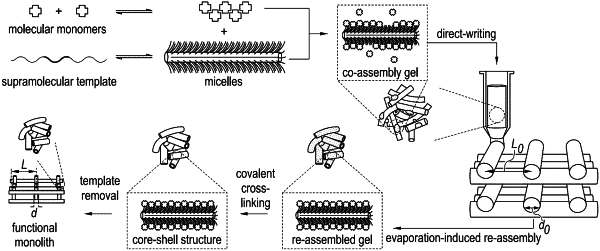| CPC C09D 11/102 (2013.01) [B29C 64/314 (2017.08); B33Y 40/10 (2020.01); B33Y 70/00 (2014.12); B29C 64/106 (2017.08); B29K 2105/0061 (2013.01); B33Y 10/00 (2014.12); B33Y 80/00 (2014.12)] | 45 Claims |

|
1. A method of manufacturing a 3-D structure, the method comprising:
(a) delivering one or more supramolecular polymer compositions onto a surface of a substrate to form the 3-D structure, wherein the 3-D structure comprises internal cavities or voids that are interconnected in one, two or three dimensions within the structure;
wherein the supramolecular polymer composition comprises a template-monomer co-assembled supramolecular polymer structure comprising:
i) a solvent;
ii) a template molecule comprising an at least partially linear amphiphilic or hydrophilic polymer;
iii) a reactive component comprising at least one monomer, wherein the monomer is capable of hydrogen bonding with the template molecule to form a 1D supramolecular structure, and wherein the monomer comprises least two groups capable of covalent crosslinking;
wherein the supramolecular polymer composition has a suitable viscoelastic property which allows for 3-D printing of the supramolecular polymer composition to form a 3-D structure, and is capable of re-co-assembly after 3-D printing to maintain the printed three dimensional (3-D) macrostructural form.
|